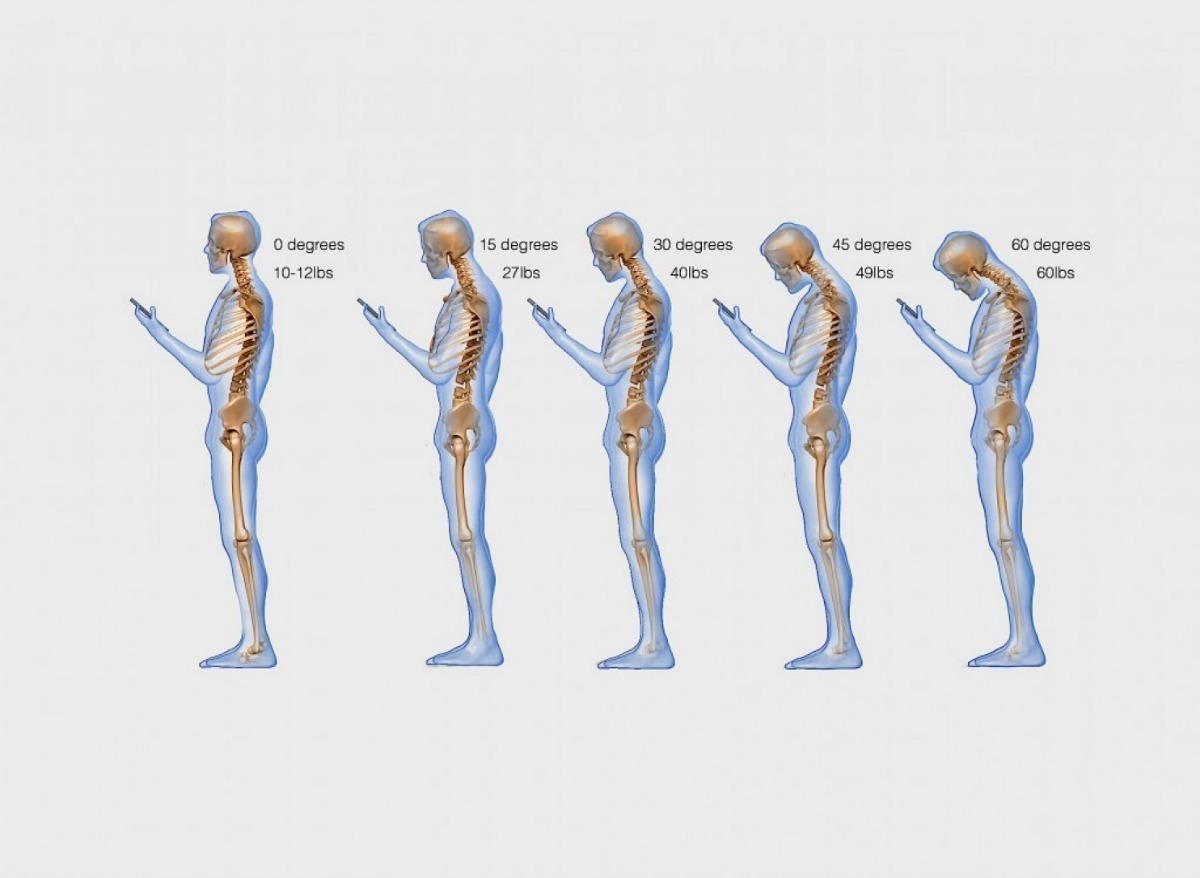
- posted: May 04, 2017
A patient presented to the office in the last week describing symptoms that have become all too common in the recent years – neck pain that is attributed to use of our devices (i.e., smart phones and tablets).
A growing amount of literature is being generated regarding the nearly epidemic levels of neck pain that is being attributed to use of our devices. The attached diagram demonstrates the issue.
Image Courtesy of Dr. Ken Hansraj, M.D.
This diagram is trying to demonstrate degrees by which the functional load on the cervical spine increases with increasing degrees of forward flexion of the cervical spine. Obvious, the head simply does not increase in weight. In a static and neutral posture the weight of the head is approximately 10-12 lbs. This does not change with movement of the cervical spine. However, the mechanism by this the load on the supporting structures of the cervical spine (i.e., vertebra and the stabilizing ligaments and musculatures) is very real. Perhaps the best way to think about this effect is to consider a simple machine – a lever. We have all used a lever to try to move a heavy object. We have been able to move a considerable weight when we have a long enough lever. This “tool” provides us with mechanical advantage. This about this from the opposite perspective, with a lever of increasing length the amount of weight needed on the short end of the lever has to increase dramatically to support even a small weight on the long end of the lever.
From a functional point of view this same effect occurs in other regions of out body. Reviewing an example from other regions might allow for a greater appreciation for how this can occur in the neck region. I’m sure we can all recall having been told, “lift things when they are held close to your body.” We have all experienced this. Try to lift a 5 gallon pail of water that is right in front of you. Heavy, but doable. Now move that 5 gallon pail two feet on front of you. Now lift. It is obviously much more difficult. As the distance from the core of your body increases the load on the musculature to perform this movement increases as a function of the distance from the axis of rotation (i.e., the lower lumbar spine).
In the parlance of physics this is called torque. The magnitude of torque is a function of both the weight of an object (the head) and the distance from the axis of rotation (the trigonometric portion of the length of the neck that is parallel to the floor). I know! We are really starting to go off into the weeds on this. Believe me; the math does really work out.
What is the nature of the symptoms one might experience?
From a general perspective it is pain. In the early stages of such an issue the pain is more muscular in nature. With prolonged loading of the posterior muscles of the neck and shoulders to support the head while in flexion, they will experience an “overuse” type of event. Obvious when muscles are used for long periods of time they fatigue and become painful. This may be rather mild in the early stages, but will increase over time. I will generally see patients when they reach a level wherein they are developing myofascial pain. We all have this to a degree. Recall the tight and knotted muscles of the upper shoulder regions? This is myofascial pain. This can become incredibly painful and can become chronic.
Over longer periods of time there will be changes to the structure of the vertebrae themselves. When the main weight bearing structure of the vertebra (the vertebral body) is exposed to frequent or prolonged forward flexion the stabilizing ligaments are loaded and stretched. This, over time, will result in irritation of the attachments of these ligaments to the bone and will result in hypertrophic changes we generally call “bone spurs.” This is a form of degenerative change to the spine and will also have associated degeneration of the intervertebral discs.
What to do about it?
1. The best point to start is with prevention. Be aware of your frequency of use of your device and also be aware of your posture.
2. If you are developing pain issues – a good starting point is to seek the opinion of a chiropractor. DC’s are very well versed in these types of issues. Many times the relative amount of care is very limited and there are self care options that can be employed.
a. Ice or Heat – depending on the intensity of your situation ice or heat therapy can be very effective. Ice if it is intense and acute, heat if it is more dull and aching.
b. Chiropractic Manipulative Therapy – with prolonged loading of the neck region there can be a change in the mechanics of the spine. Altered mechanics results in pain and inflammation of the posterior joints of the spine (i.e., the facet joints).
c. Ultrasound Therapy – in instances of more intense and prolonged pain issues we have to consider the introduction of more therapy options. US is an excellent therapy to gain control of elevated levels of myofascial activity.
For further and very recent information please see:
“Text neck”: an epidemic of the modern era of cell phones?, Jason M. Cuéllar, MD, PhD, Todd H. Lanman, MD, The Spine Journal: March 2017.
Location
590 4th St
Prairie Du Sac, WI 53578, USA
HOURS OF OPERATION
8:30 AM - 6:00 PM
8:30 AM - 5:00 PM
8:30 AM - 6:00 pm
8:30 AM - 12:00 PM
8:00 AM - 5:00 PM
Closed
Closed
